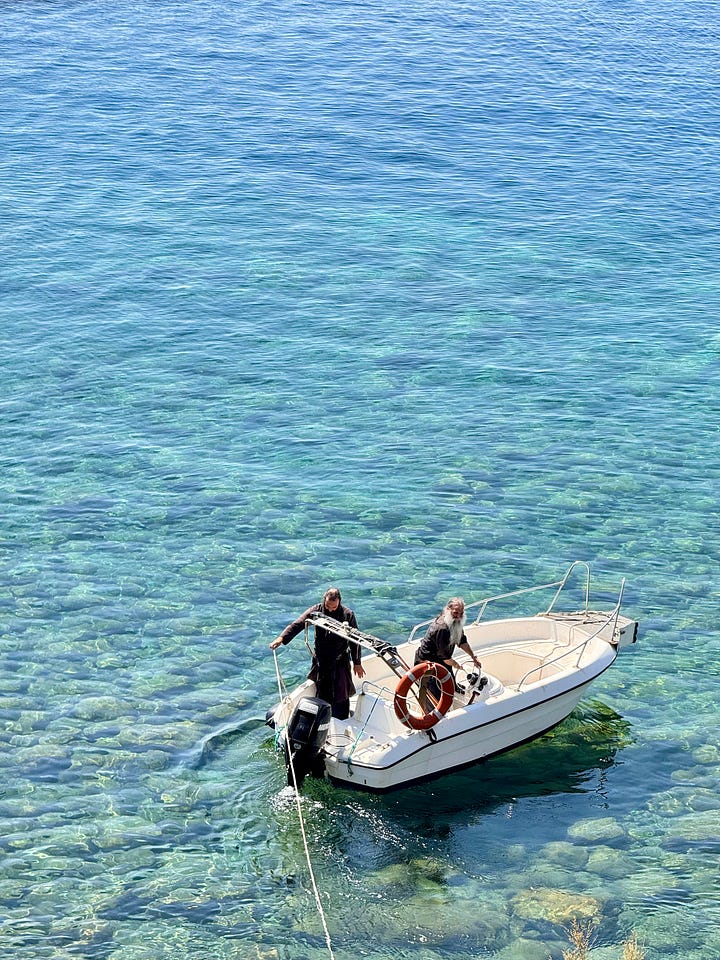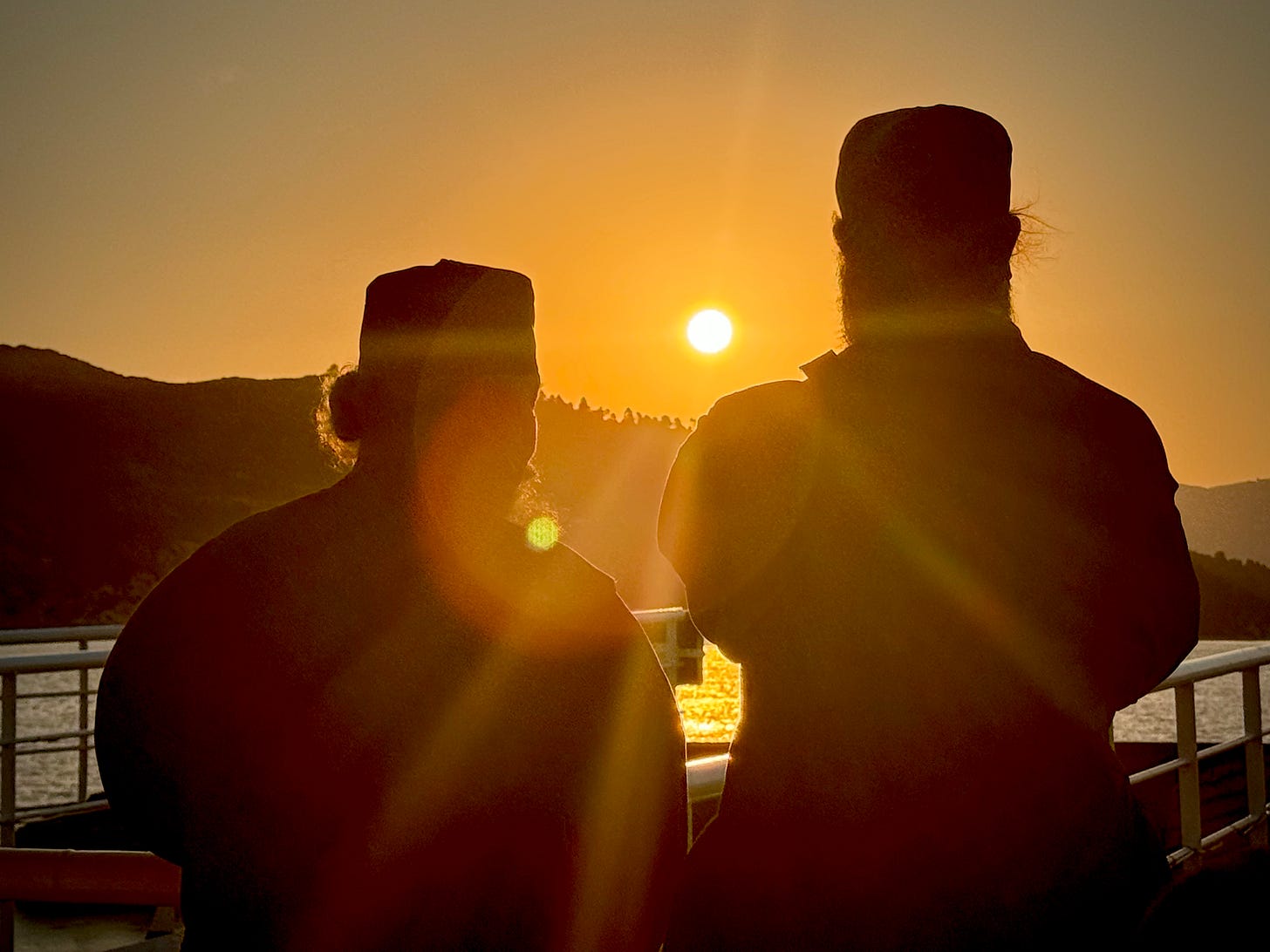Mount Athos, the Monastic State Where No Woman Has Set Foot for a Millennium and the Fallen Byzantine Empire Lives
My pilgrimage to Mount Athos was the closest I got to time travel, as it has changed less than just about anywhere on Earth for a millennium.
📍 Mount Athos, Greece
I had thought the Byzantine Empire was bygone—a chapter in history that closed with the fall of Constantinople to the Muslim armies of the Ottoman Empire in 1453. But on Mount Athos, an autonomous monastic state in the cerulean Aegean Sea, time seems to have stopped a thousand years ago. This rugged peninsula, jutting out from the eastern coast of Greece, is home to over 2,000 residents—all Orthodox monks whose lives are a ceaseless prayer. No woman has legally set foot on the peninsula’s hallowed ground since the Virgin Mary herself—and that includes non-native female animals, with the exception of cats and chickens, valued for their mousing and egg-laying abilities, respectively. Nowhere is Christianity practiced as close to how it was during the time of Jesus Christ himself.
Mount Athos may have embraced change less than anywhere else on Earth. As one of the rare non-Orthodox pilgrims to visit the monastic republic (and the only one at every monastery I visited), I repatterned my life to match that of this time capsule—where everyone, without exception, is on the same page in Byzantine history. The moment I collected my Athos visa, called a Diamonitirion, and boarded the ferry from the Greek town of Ouranoupoli, the last stop located in the 21st century, my spirit found solace in the holy peninsula’s rhythms of life. I felt beyond welcomed under the doting guidance of monks and veteran pilgrims, who never missed a chance to enrich me with context and describe what rituals meant to them—even as they bemoaned the fact that I’m not baptized.
Welcomed by the monks of Simonos Petras on my first night in Byzantium, I felt as if I had traveled back a millennium. Here, prayers echo with the promise of an afterlife, a timeless bridge between the past and the future.
On this peninsula with a centuries-long prohibition on women, every prayer is uttered in reverence of a woman: the Virgin Mary. Legend has it that Mary, the mother of Jesus, was sailing to Cyprus when a storm blew her ship off course and onto the shores of Athos. Enchanted by its serene beauty, verdant forests of chestnut and cypress trees, and crystal-blue waters, she prayed to God to make the peninsula her own garden, a sanctuary where she could find peace and solace. When her wish was granted, the peninsula was forever consecrated to her. From that point on, Athos became a haven for men seeking spiritual enlightenment, a place where the divine feminine is revered in the absence of the human feminine.






Mary is to be honored without distraction—the quicksand of prayer. The monks warned me that distractions come in various forms: food that is too tasty (Athos only serves simple fare better scarfed down than savored), people who are too seductive (women), and even friendships that are too close. The monks aren’t “friends”; they are “brothers.” Even during meals, they don’t converse but eat mechanically as the prayer continues. Never have I felt so present for the sake of something in the future: the afterlife.

This pin-pointed presentness is hard to recreate in today’s world. On Athos, the only visible signs of modernity are the occasional solar panel, satellite dish and motorized vehicle. The air is thick with the scent of incense, beeswax candles, and the salty sea breeze; the only sounds are the rhythmic chants of monks, the rustling of leaves, and the gentle lapping of waves against the shore. Yet, this archaic peace doesn’t mean the monks are disconnected from the world they have left behind. I had nuanced discussions with them on topics ranging from Donald Trump’s campaign to Elon Musk’s Hyperloop, social media content moderation, the perils of today’s multipolar world, “Grexit” (the movement for Greece to exit the EU rather than submit to bailouts), and just about everything in between.
I was surprised by how up-to-date the monks were, despite being deliberately and literally out-of-date. Mount Athos is the only place in the world that still keeps Byzantine time. For over 500 years, clock towers on the peninsula have been several hours off from the rest of Greece, with the day beginning at sunset, not at midnight. The monastic peninsula is the last place that follows the Julian calendar, which has been obsolete since 1582 and is thirteen days behind the Gregorian calendar used by the rest of the world. The measurement, passage, and entire experience of time here are different, feeling both frozen and eternal. In the day-to-day, this alien rhythm meant that I was up for 4 a.m. vespers, hours of deep baritone chants that filled the church with hypnotic, centuries-old melodies.
Historically, preserving this unique existence would not have happened but for a long chain of carve-outs and exemptions granted by the empires that ruled modern-day Greece since Byzantium. When Athos fell under Ottoman rule, the sultans agreed to grant it a special status of self-governance. Later, when Greece gained independence from the Ottomans in the 19th century, Athos’s autonomy was enshrined in the Greek constitution. During World War II, the monks shrewdly avoided Nazi interference by securing special status and then benefiting from Hitler being too occupied with Russia to loot their historical treasures. More recently, the European Union, with its laws on gender equality, challenged Athos’s male-only policy, arguing it violates women’s rights. However, the Greek government came to Athos’s defense, even threatening to grant the peninsula full independence, similar to Vatican City, so that they could preserve the prohibition. The Holy Mountain stayed frozen following centuries of circumstantial and strategic sheltering.


The monasteries themselves are architectural marvels, and I was particularly taken by Simonos Petras, whose monks graciously housed me for my first night in Byzantium incarnate. This cliff-top monastery appears structurally impossible, emerging from a jagged peak overlooking the Aegean – a blue expanse serene that it proved capable of bringing down my resting heart rate. Other monasteries, like the sprawling Great Lavra—the oldest and largest on the peninsula—are complex compounds resembling small cities, with courtyards, gardens, and intricate networks of passageways. Inside, each glistens with mosaics and exquisite frescoes depicting scenes from the Bible and the lives of the saints painted by the monks themselves.

The monks take their duty toward—and access to—the most “unadulterated” form of the Christian faith seriously. They spend countless hours poring over ancient manuscripts, some of which are carefully preserved originals from the Byzantine Empire, seeking ever more proximity to the divine. Yet beyond the uniform black robes, bushy beards, and strict adherence to their lives of ceaseless prayer, I found a surprising diversity among the monks. Father Lukas of Simonos Petras is a genetics PhD from the University of Cambridge who is proudly, and non-oxymoronically, both a former scientist and a present monk. To him, those two are not at odds. He explained that human beings have “tapped out” on evolution now that we’ve achieved full domination over nature. The only forward trajectory left for us as a species is a metamorphosis beyond the realm of science, into the “Kingdom of God.”


Father Jeremiah of Xenophontos welcomed me with curiosity and warmth in this authentic Texas twang. When he arrived on Athos for his three-year trial (joining the monastic order is tantamount to marriage and a lifelong commitment), he donned cowboy boots beneath his robe. Jeremiah might be the opposite of what I had in mind as a prototypical monk: he grew up Baptist, was in a rock band, and had a turbulent childhood. I met monks who were mechanical engineers, physicians, historians, computer programmers, and more before they left it all to mute the distractions of modern life. The monks hailed from all corners of the world — from Boston, to Beirut, to Bali — before coming to Athos to stay forever.
Glimpses of Xenophontos: where time slows, faith deepens, and beauty surrounds.
Most of the monks are not hermits but rather vibrant members of communities—mostly monasteries, but also sketes (essentially villages with separate houses) and hermitages. Some welcome visitors, offering complimentary room and board and immersion into their Spartan, self-sufficient existence, free from any dependency that could detract from their unwavering devotion to God. They rise before dawn, long before the crow of a rooster (or on Athos, the haunting howl of endemic wolves), when a single bell, their call to prayer, sounds. They grow their own food (in Xenophontos, I found a cornucopia of banana, plum, and lemon trees all beside the main church), fish in the surrounding waters, and even brew their own wine—which flows freely right from their morning breakfast.



The Holy Mountain is home to twenty sovereign monasteries—seventeen of which are Greek, with the remaining three representing the Bulgarian, Serbian, and Russian Orthodox traditions. Greek serves as the lingua franca among the monastic communities, which are governed by the Sacred Community, composed of representatives from each monastery. This communal governing body oversees the peninsula's affairs, ensuring that the monastic traditions are upheld and that the delicate balance between autonomy and unity is maintained. Each monastery, led by an abbot elected for life by the monks, exercises near total autonomy in its internal affairs. This ancient system has presided over modern matters, such as the COVID-19 pandemic, during which each monastery’s abbot took his own stance on the safety of mRNA vaccines, mitigating infection risk from incoming pilgrims, and establishing general protocols.



For me, even as a non-Orthodox pilgrim, Athos was a mystical realm. It was a journey into a world devoid of the inevitable distractions of modern life, with a singular focus not on the here and now, but on the back then and eternal. If there is one place on Earth where time truly stands still, it’s here. The Holy Mountain has a pacifying effect, making exiting a modern world that can feel weary, sometimes even tattered, feel like an embrace.
I am not an Orthodox Christian and did not experience Athos like one. But what I took away from the holy peninsula is universal: the power of singular focus and intention. The fathers taught me that when there is a void, humans will fill it. The body, they say, is a “vessel” that they fill to the brim with the Holy Spirit, crowding out any space for inevitable demonic distractions. When I act without intention in my life, I leave myself vulnerable to voids. Although not as destructive as the anti-Christ that the monks might fear, these voids can lead to fruitless meandering and avoidable blockages between my body and spirit.
Pilgrims arrive at the sacred shores of Mount Athos, disembarking at the port of Daphne.
The monks prompted me to ponder the ways distraction plays an amplified and unwarranted role in my life. They described the nature of God’s miracles as humble and the anti-Christ’s as impressive to the point of being seductive. I thought about the various traps I get seduced by, such as progressing professionally along trajectories that appeal to me because externally they woo and are bejeweled. Obviously, for me, the answer is not joining a monastic order and opting out of the world, but to operate in that context as they do in theirs: with modesty and intention.







Adam is a superlative storyteller. I now must go to Mount Athos.
Enjoyed immensely learning and mentally experiencing thanks to the beautiful writing.